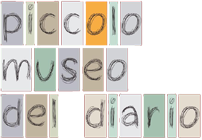For years, while entering Pieve Santo Stefano, a yellow sign with the words “City of the Diary” has attracted and intrigued visitors. They crossed the threshold of the Porta Pretorio Palace and climbed up the “sixteen steps”, expecting to access a regular museum: instead, they found themselves in front of a row of red and green folders, with texts divided both by years of admission and alphabetical order. Some real treasures were hidden from sight: treasures like Clelia Marchi’s bed sheet, which used to be folded into a case and exhibited only once a year, on the three days of the Pieve Prize, until 2013.
For years, staff and collaborators of the Archive have pulled out the diaries from their files and told stories related to them. Stories sometimes related to the text and sometimes to the way it took to get to Pieve.
Once the Bed Sheet started to be exhibited, we found natural to give room to other manuscripts and other autobiographical stories, too. That’s how we started to share and tell stories, that’s what we still do in the museum rooms.
When actor, director and playwright Mario Perrotta entered the Archive for the first time, he imagined that the alphabetical order imposed on the diaries might create some rather odd combinations: a partisan would stand close to a fascist, a nun next to a prostitute. Back at that time, the Archive was looking for someone able to draw up a book celebrating the first 25 years of its life. It was July 2007 and Il paese dei diari (The town of diaries) was edited by Terre di Mezzo in September 2009.
The book of Perrotta was the main source of inspiration for dotdotdot in the making of the Piccolo Museo del Diario. The visitor will find many correspondences with the narration, starting from the idea of the diaries leaving their shelf at night, flying away in search of similar stories, then creating that “rustle of others” that gave rise to the first installation of the museum. The very figure of Saverio Tutino has a special place through the pages of “Il paese dei diari”, since he used to have a special place in the town of Pieve S. Stefano, too. As Perrotta writes, «it was not Saverio who chose Pieve, but Pieve that chose Saverio».

